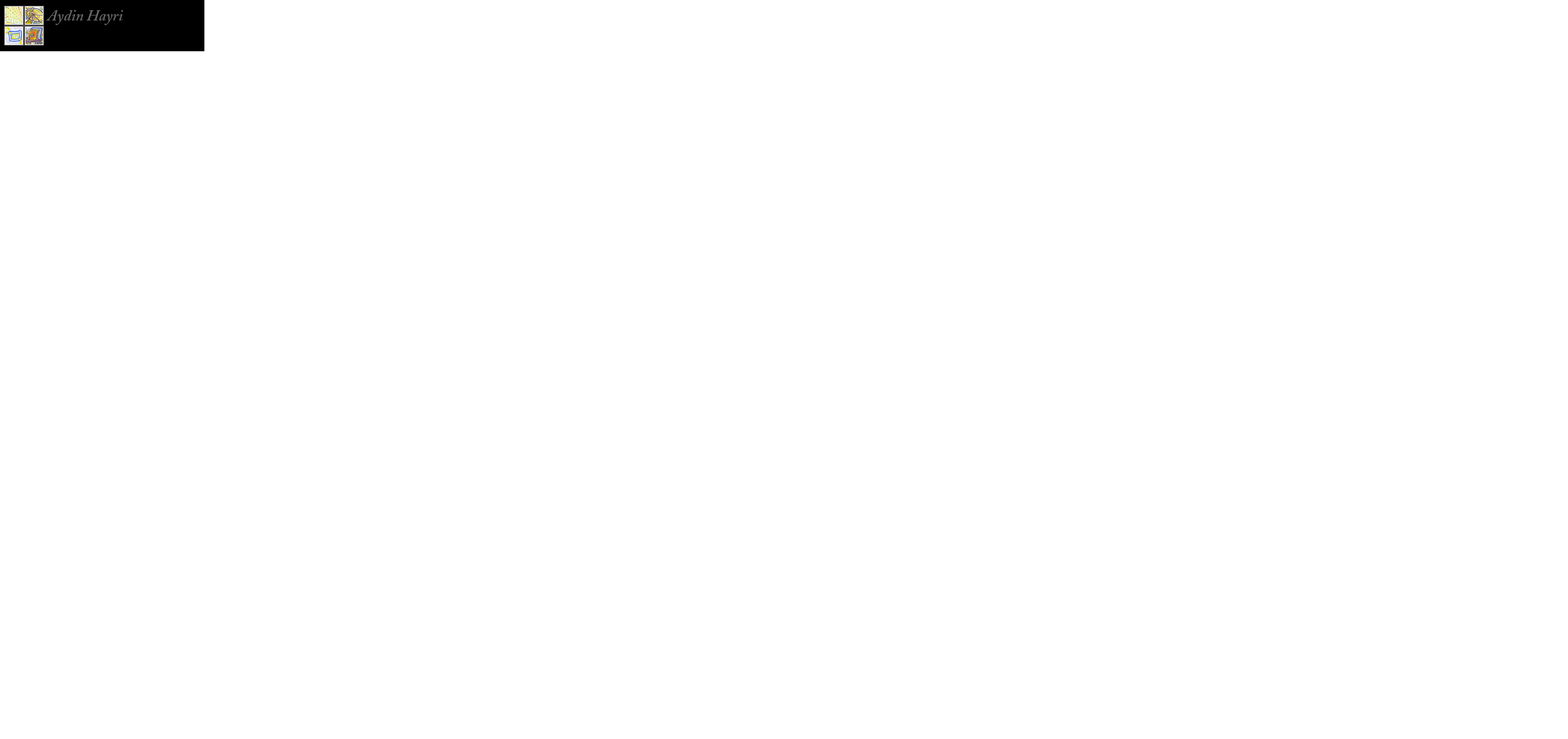Desert Rose
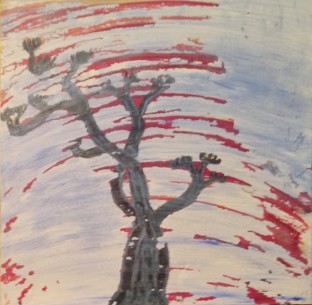 Desert Rose, Aydin Hayri, 2013. Acrylic on laminated particle board. 12” × 12
In the winter of 2013, our family took a driving trip of Morocco. One image stood out from that trip — the desert rose — I do not know whether it is the official or correct name for this plant, but here is how it looks, an ungainly, bulbous stem and sharply narrowing stems and leaves, with unexpectedly beautiful flowers.
What may come across as an ugly duckling is a streamlined plant, surviving in an extreme environment. Due to difficulty of applying paint on a laminated particle board, created this stripped paint look of a sandstorm, showing the desert rose withstanding a sustained attack with grace, presumably to blossom on another day. I think I will keep visiting the desert rose theme, trying different depictions of this long serving, diligent plant.
$120.-
Desert Rose, Aydin Hayri, 2013. Acrylic on laminated particle board. 12” × 12
In the winter of 2013, our family took a driving trip of Morocco. One image stood out from that trip — the desert rose — I do not know whether it is the official or correct name for this plant, but here is how it looks, an ungainly, bulbous stem and sharply narrowing stems and leaves, with unexpectedly beautiful flowers.
What may come across as an ugly duckling is a streamlined plant, surviving in an extreme environment. Due to difficulty of applying paint on a laminated particle board, created this stripped paint look of a sandstorm, showing the desert rose withstanding a sustained attack with grace, presumably to blossom on another day. I think I will keep visiting the desert rose theme, trying different depictions of this long serving, diligent plant.
$120.-Stuck
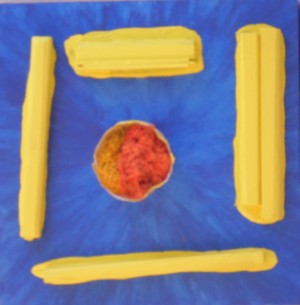 Stuck, Aydin Hayri, 2013. Acrylic paint, wood, wire mesh, natural moss on wooden board, 8″ x 8″.
Here is another variation on the theme of our desire to protect our valuables, sometimes at the cost of strangling our creativity or locking up our potential. Here the pile of moss in the middle represents our creative potential, protected by a wire mesh fence, against the intrusions of the ocean. The four barriers appear to be run over. The protection also becomes a restriction. We are protected and stuck at the same time. Hard to tell, in this work of art, as well as in life, when we are stuck versus just being well protected.
$100.-
Stuck, Aydin Hayri, 2013. Acrylic paint, wood, wire mesh, natural moss on wooden board, 8″ x 8″.
Here is another variation on the theme of our desire to protect our valuables, sometimes at the cost of strangling our creativity or locking up our potential. Here the pile of moss in the middle represents our creative potential, protected by a wire mesh fence, against the intrusions of the ocean. The four barriers appear to be run over. The protection also becomes a restriction. We are protected and stuck at the same time. Hard to tell, in this work of art, as well as in life, when we are stuck versus just being well protected.
$100.-Misplaced Meaning
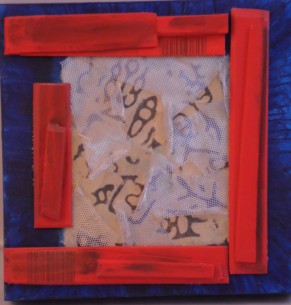 Misplaced Meaning, Aydin Hayri, 2013. Acrylic paint, wood, paper, wire mesh on wood board, 8″ x8″.
This is a study of our efforts to preserve things we find valuable, yet often failing in that effort. Here rotting wood barriers are erected and a wire mesh is stretched over to protect the layers of gibberish writings against the intruding blue (ocean?). Whatever original meaning may have been out there has been covered over and repaired with patches and the efforts to neatly hold it together with a wire mesh cover have apparently failed. I retained the barcodes on the pieces of wood to emphasize the systematic efforts we (as human communities) go through to protect something we believe or hope to be valuable even if the “thing” may have lost its meaning.
$100.-
Misplaced Meaning, Aydin Hayri, 2013. Acrylic paint, wood, paper, wire mesh on wood board, 8″ x8″.
This is a study of our efforts to preserve things we find valuable, yet often failing in that effort. Here rotting wood barriers are erected and a wire mesh is stretched over to protect the layers of gibberish writings against the intruding blue (ocean?). Whatever original meaning may have been out there has been covered over and repaired with patches and the efforts to neatly hold it together with a wire mesh cover have apparently failed. I retained the barcodes on the pieces of wood to emphasize the systematic efforts we (as human communities) go through to protect something we believe or hope to be valuable even if the “thing” may have lost its meaning.
$100.-Bitter, Sweet Freedom
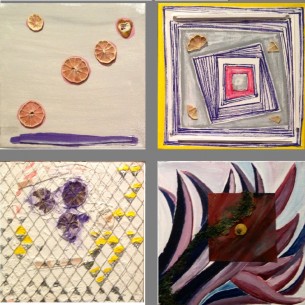 Bitter, Sweet Freedom, Aydin Hayri, 2014. Acrylic paint, wire mesh, lemon slices and other found objects, 24” x 24”
In this four panel series I continue my exploration of our desire for freedom versus preservation of our valuables (represented here with dried lemon slices). However we choose to protect them, under lock, or through camouflage, or by putting boxes around them, there is an irrepressible desire to fly away, but such flight is not without its own hazards, as the mutilated slices on the top left panel depicts. Ways we try to protect ourselves or our valuables is immensely diverse and stupefying, but somewhat futile.
The exhibition shows only the three of the four panels.
$100 per panel
Bitter, Sweet Freedom, Aydin Hayri, 2014. Acrylic paint, wire mesh, lemon slices and other found objects, 24” x 24”
In this four panel series I continue my exploration of our desire for freedom versus preservation of our valuables (represented here with dried lemon slices). However we choose to protect them, under lock, or through camouflage, or by putting boxes around them, there is an irrepressible desire to fly away, but such flight is not without its own hazards, as the mutilated slices on the top left panel depicts. Ways we try to protect ourselves or our valuables is immensely diverse and stupefying, but somewhat futile.
The exhibition shows only the three of the four panels.
$100 per panelLost Knowledge
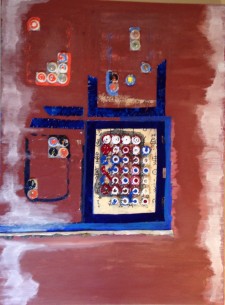 Lost Knowledge, Aydin Hayri, 2013. Acrylic paint, natural pigments, found objects on canvas, 40” × 30
Today’s information overload makes knowledge harder and harder to retain. This painting started my exploration of lost valuables that we try hard to protect. In this case, knowledge, appears to be lost, washed away in the deluge of information. Knowledge is represented by the “letters” visible in the background. These are not from any particular alphabet, but random figures printed on a gift wrap paper. They represent the literary knowledge codified into the structured cells. The cells show that chaotic fight of different colors — we see one color engulfing the other.
There is barrier at the bottom that was meant to protect them, but, apparently, has not been effective. The barrier is made by natural stones, held in place by paint. I use this motif of a barrier in different paintings. Here there is a flap over the barrier made from an extra piece of canvas. The original inspiration for this painting was a photograph of a window on an earthen stucco wall — I cannot find the photograph or the reference to it, but it was a magazine published by GW Hospital doctors showing different works of art by the doctors.
$900.-
Lost Knowledge, Aydin Hayri, 2013. Acrylic paint, natural pigments, found objects on canvas, 40” × 30
Today’s information overload makes knowledge harder and harder to retain. This painting started my exploration of lost valuables that we try hard to protect. In this case, knowledge, appears to be lost, washed away in the deluge of information. Knowledge is represented by the “letters” visible in the background. These are not from any particular alphabet, but random figures printed on a gift wrap paper. They represent the literary knowledge codified into the structured cells. The cells show that chaotic fight of different colors — we see one color engulfing the other.
There is barrier at the bottom that was meant to protect them, but, apparently, has not been effective. The barrier is made by natural stones, held in place by paint. I use this motif of a barrier in different paintings. Here there is a flap over the barrier made from an extra piece of canvas. The original inspiration for this painting was a photograph of a window on an earthen stucco wall — I cannot find the photograph or the reference to it, but it was a magazine published by GW Hospital doctors showing different works of art by the doctors.
$900.-Pop-Up Island
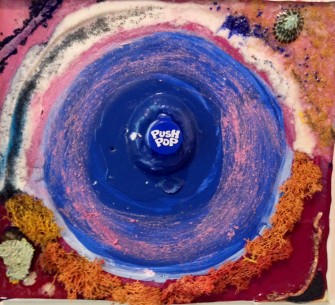 Aydin Hayri, 2014. Acrylic, seashells, moss, foam, plastic candy cap on canvas, 10″ x 10″
As you may know, most islands in the South Pacific, and elsewhere were pop-up islands. Here is another one!
This one is an inverted image, island being a clean, blue disk in a sea of darker and cluttered sea, with an inviting beach on its north side. The Push-Pop cap in the middle has been the key element around which I built this fictional island. One can read more into it: One view may be that the Pop-Up Island may be an effort by the earth to restore the tranquility of the seas. The opposite view may be that the Pop-Up Island is a theme park that just popped up in the cluttered waters around it.
My thinking is that visual arts should provide an aesthetically attractive and remarkable vessel to be filled with contemplations and thoughts of its viewers.
$200.-
Aydin Hayri, 2014. Acrylic, seashells, moss, foam, plastic candy cap on canvas, 10″ x 10″
As you may know, most islands in the South Pacific, and elsewhere were pop-up islands. Here is another one!
This one is an inverted image, island being a clean, blue disk in a sea of darker and cluttered sea, with an inviting beach on its north side. The Push-Pop cap in the middle has been the key element around which I built this fictional island. One can read more into it: One view may be that the Pop-Up Island may be an effort by the earth to restore the tranquility of the seas. The opposite view may be that the Pop-Up Island is a theme park that just popped up in the cluttered waters around it.
My thinking is that visual arts should provide an aesthetically attractive and remarkable vessel to be filled with contemplations and thoughts of its viewers.
$200.-Wildflower of a Sailboat
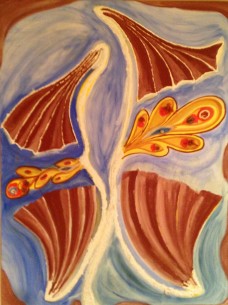 Wildflower of a Sailboat, Aydin Hayri, 2013, Acrylic paint, sand, and found objects on canvas, 40” × 30
I am not at all fond of painting nature. So I thought about an unnatural flower, but with still a flower — it has rounded edges and 5 stripes on its leaves and 5 buds on its flowers. Leaves attach laboriously from their far end, they stretch like sails – with the white stem like the mast of an invisible boat. The background of varying blues with broad brush strikes enhances this marine theme, yet the earth colored framing around it make you wonder the vantage point from which we may be watching this wild flower of a sailboat glide by.
$900.-
Wildflower of a Sailboat, Aydin Hayri, 2013, Acrylic paint, sand, and found objects on canvas, 40” × 30
I am not at all fond of painting nature. So I thought about an unnatural flower, but with still a flower — it has rounded edges and 5 stripes on its leaves and 5 buds on its flowers. Leaves attach laboriously from their far end, they stretch like sails – with the white stem like the mast of an invisible boat. The background of varying blues with broad brush strikes enhances this marine theme, yet the earth colored framing around it make you wonder the vantage point from which we may be watching this wild flower of a sailboat glide by.
$900.-Strips
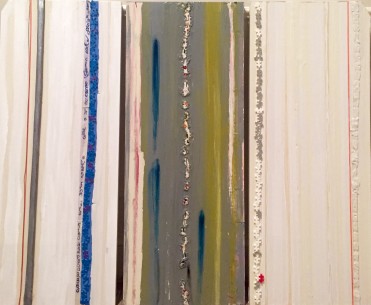 Strips…, Aydin Hayri, 2014, paper, acrylic, string, found objects on wood panels, 30″ x 36″
On 3 old shelves, I started an aesthetic assault of applying layers of paper, tape, paint and varnish. For me different strips laid side by side is a reflection of our malleability. Even with no ill-intend, we ask ourselves to recount or describe the same event, we will come up with different versions of the facts. While this may bother some folks but, for me, it is yet another indication of the futility of chasing universal truths and absolutes, every strip ends up being different, although we start with the same intentions.
The board on the left has the inscription “he can see the world clearly because he was excluded from its rites and passages,” a sentence composed by Hilton Als in his review of a Shakespeare play, linking the piece to “seeing.” But what do we exactly see when we look at the Egyptian hieroglyphs embedded in the healing wound that runs through the middle of the middle board? What they represent would be different to us than the ancient Egyptians, I would imagine. The board on the right has two rows of “Plus-Plus,” little plastic pieces shaped as double plus signs (hence the name), an anti-Lego French toy, our ability to make and remake things.
$200 per panel
Strips…, Aydin Hayri, 2014, paper, acrylic, string, found objects on wood panels, 30″ x 36″
On 3 old shelves, I started an aesthetic assault of applying layers of paper, tape, paint and varnish. For me different strips laid side by side is a reflection of our malleability. Even with no ill-intend, we ask ourselves to recount or describe the same event, we will come up with different versions of the facts. While this may bother some folks but, for me, it is yet another indication of the futility of chasing universal truths and absolutes, every strip ends up being different, although we start with the same intentions.
The board on the left has the inscription “he can see the world clearly because he was excluded from its rites and passages,” a sentence composed by Hilton Als in his review of a Shakespeare play, linking the piece to “seeing.” But what do we exactly see when we look at the Egyptian hieroglyphs embedded in the healing wound that runs through the middle of the middle board? What they represent would be different to us than the ancient Egyptians, I would imagine. The board on the right has two rows of “Plus-Plus,” little plastic pieces shaped as double plus signs (hence the name), an anti-Lego French toy, our ability to make and remake things.
$200 per panel
Union
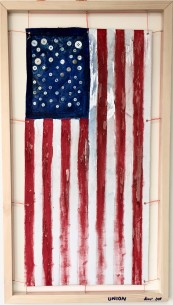 Union, Aydin Hayri, 2015. Acrylic and buttons on canvas, 24” × 12”
It was inevitable that I would want to do a rendition of the Star Spangled Banner, the flag of my adopted country. What I love about America is that it contains a piece of every other nation, an amalgam of all cultures, and all peoples. It is the starter home for the United States of the World. Hence the diversity among the stars, with buttons, as symbols of unity – are not the buttons the most basic fastener? Buttons were all we had before glues, zippers, and Velcro?
The course of a union, especially one of states, making an analogy to what the Bard said about love, “never runs smooths.” Hence the worn out stripes. Yet the flag is stretched by its own weight – the thread running through the eyelets pulls it tight when hanged.
$900.-
Union, Aydin Hayri, 2015. Acrylic and buttons on canvas, 24” × 12”
It was inevitable that I would want to do a rendition of the Star Spangled Banner, the flag of my adopted country. What I love about America is that it contains a piece of every other nation, an amalgam of all cultures, and all peoples. It is the starter home for the United States of the World. Hence the diversity among the stars, with buttons, as symbols of unity – are not the buttons the most basic fastener? Buttons were all we had before glues, zippers, and Velcro?
The course of a union, especially one of states, making an analogy to what the Bard said about love, “never runs smooths.” Hence the worn out stripes. Yet the flag is stretched by its own weight – the thread running through the eyelets pulls it tight when hanged.
$900.-Flag as a Self-Portrait — Layer it on!
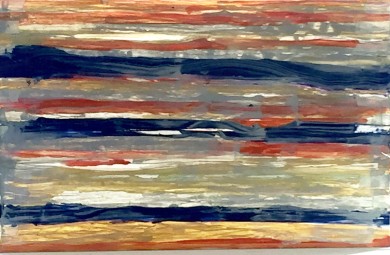 Flag as a Self-Portrait – Layer it on! Aydin Hayri, 2015. Acrylic, string, steel wire, and tape on glass, 8” × 16”
Layers. Put on layers to keep warm. Put on layers of paint to cover the old, ugly, worn out. Put on layers beautify potholed, crumbling road, or skin.
Layering assigns meaning to ourselves, projecting our presumed identity to the world.
Layering assigns meaning to our lives, covering what needs to be forgotten so as to move forward.
There is nothing original bout layering. Many visual artists have done it before. In this work I pay homage to Gerhard Richter whose 2002 MOMA exhibit rekindled, rejuvenated my interest in art.
This is also a self-portrait of sorts as I continue to build my “self” by layering on different strands. Some layers are meant to cover the old, like the blue, reddish, and yellowish paint stripes, others are just to provide an accent, like the wire and the string. Taping in the back represents the improvised nature of my layering and making of my “self.”
$500.-
Flag as a Self-Portrait – Layer it on! Aydin Hayri, 2015. Acrylic, string, steel wire, and tape on glass, 8” × 16”
Layers. Put on layers to keep warm. Put on layers of paint to cover the old, ugly, worn out. Put on layers beautify potholed, crumbling road, or skin.
Layering assigns meaning to ourselves, projecting our presumed identity to the world.
Layering assigns meaning to our lives, covering what needs to be forgotten so as to move forward.
There is nothing original bout layering. Many visual artists have done it before. In this work I pay homage to Gerhard Richter whose 2002 MOMA exhibit rekindled, rejuvenated my interest in art.
This is also a self-portrait of sorts as I continue to build my “self” by layering on different strands. Some layers are meant to cover the old, like the blue, reddish, and yellowish paint stripes, others are just to provide an accent, like the wire and the string. Taping in the back represents the improvised nature of my layering and making of my “self.”
$500.-Aydin’s Art – Video Presentation: Aerial View of Fields in Winter 2014
In the video below, I discuss my latest work of art, Aerial View of Fields in Winter, December 2014:
Click below for accessing the same video on YouTube: http://youtu.be/5IXna58vKmw
